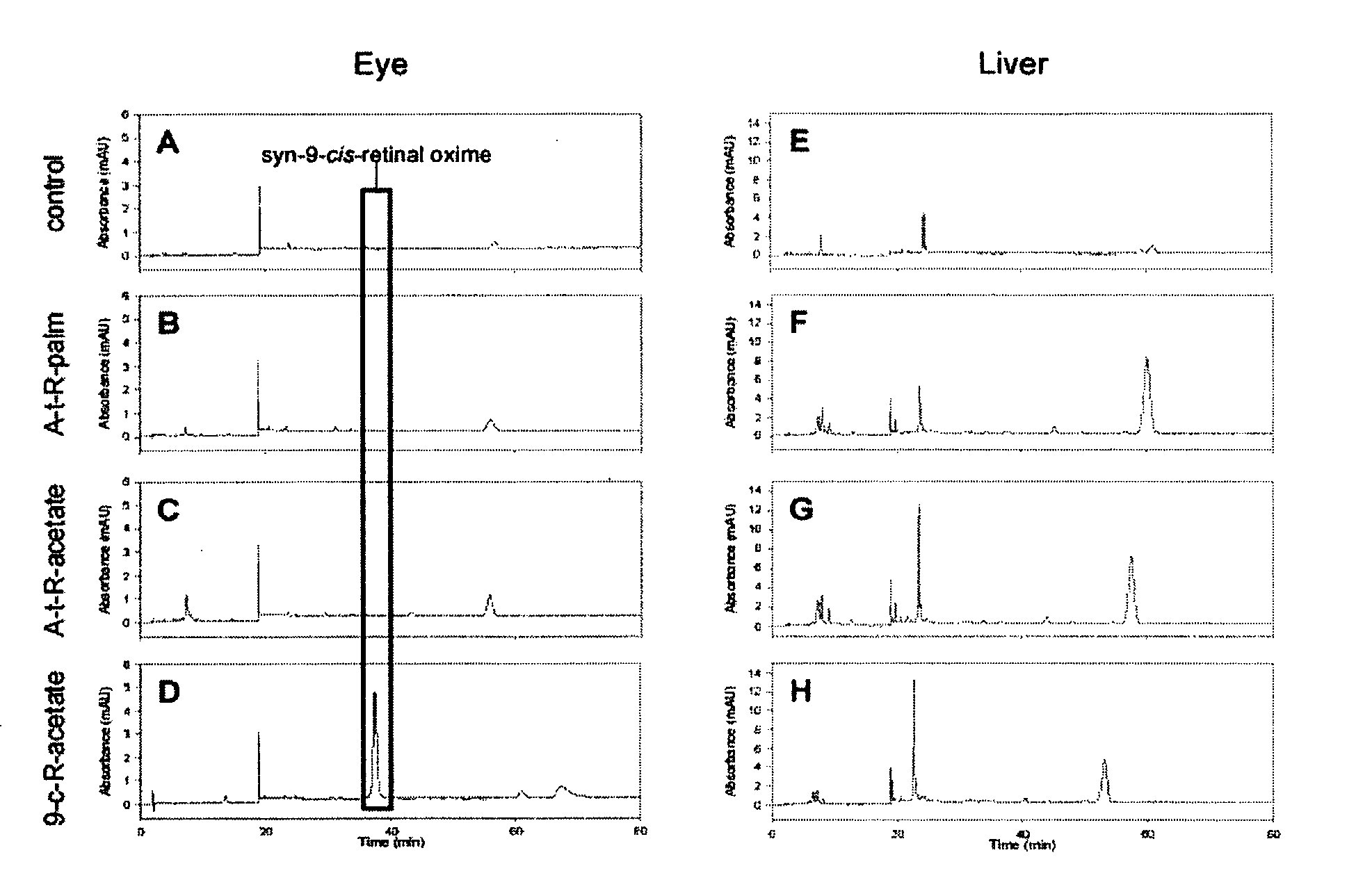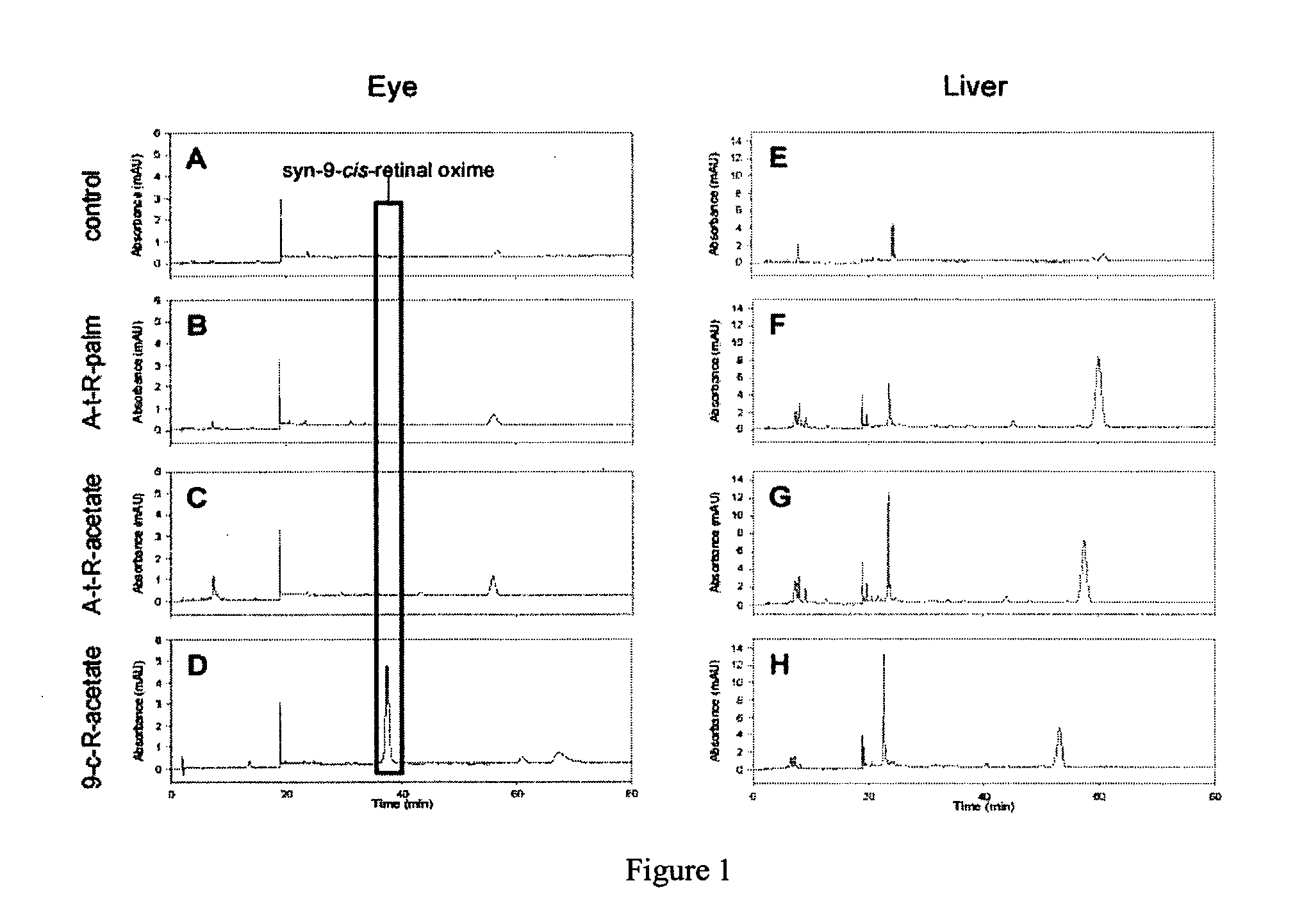Retinal Derivatives and Methods for the Use Thereof for the Treatment of Visual Disorders
a technology of retinal derivatives and derivatives, applied in the field of retinal derivatives, can solve the problems of reduced visual acuity and even blindness, damage to the macula, and increased risk of choroidal neovascularization (cnv) in the other eye of patients with wet amd in one ey
- Summary
- Abstract
- Description
- Claims
- Application Information
AI Technical Summary
Benefits of technology
Problems solved by technology
Method used
Image
Examples
example 1
[0124]9-cis-retinyl ester restores visual pigment in an LCA mouse model. LRAT− / − mice were gavaged with all-trans-retinyl palmitate, all-trans-retinyl acetate or 9-cis-retinyl acetate as indicated in the legend to FIG. 1. Following treatment, retinoids were extracted from the eye and liver, and analyzed by HPLC. As shown in FIG. 1 left, treatment of mice only with 9-cis-retinyl acetate, but not with all-trans-retinyl analogs restored the presence of syn-9-cis-retinal oxime, indicating formation of the chromophore and restoration vision in these mice. No significant retention of retinoids was observed in liver, where LRAT is highly expressed, indicating low or no toxicity by retinoids in this animal model of human LCA. 9-cis-retinyl ester restores visual pigment in approximately 5 hr (FIG. 2), while excess of retinoid is removed and metabolized (as illustrated for 9-cis-retinol).
example 2
[0125]Vitamin A and its derivatives can isomerized upon exposure to light. For example, Rao et al. (Tetrahedron Letters 31:3441-44 (1990)) showed photoisomerization of all-trans-retinol acetate (a derivative of Vitamin A) using a broad wavelength UV light could produce a mixture of all-trans, 13-cis, and 9-cis retinol acetate isomers. However, this methods is generally inefficient and produces small amounts of such retinoid.
[0126]Methods
[0127]Solutions of all-trans-retinoids are made to concentrations of 1 mg / mL in methanol. The solutions are added to a glass petri dish and subjected to 365 nm UV light using a Bio-Rad GS Genelinker with the stock bulbs replaced with 8 watt F8T5 bulbs, for varying lengths of time dependent on the target retinoid. This wavelength is beneficial, as shorter wave length light quickly destroys retinoids. Following UV-treatment, the solutions are dried down, dissolved in hexane, and purified using normal phase HPLC. Conversion yields vary for each all-tran...
example 3
[0132]Levels of 9-cis-RAL oximes (measured as syn- and anti-9-cis-retinyl aldehyde) in the eyes of Lrat− / − mice after a single dose or multiple doses of 9-cis-retinyl-acetate (9-cis-R-Ac). Doses of 9-cis-R-Ac were administered to Lrat− / − mice by oral gavage in vegetable oil (100% canola oil) in a volume of 500 μl (2.5 mg / ml). The mice weighed about 30-50 g. After 3 days, 9-cis-RAL oximes levels were determined by HPLC. Briefly, all experimental procedures related to extraction, derivatization, and separation of retinoids from dissected mouse eyes were carried out as described previously. See Van Hooser et al., J. Biol. Chem. 277:19173-182 (2002); Van Hooser et al., Proc. Natl. Acad. Sci. USA 97:8623-28 (2000); Maeda et al., J. Neurochem. 85:944-56 (2003). All reactions involving retinoids were carried out under dim red light.
[0133]Referring to FIG. 5a, the level of 9-cis-RAL in Lrat− / − in mouse eyes after a varying dose of 9-cis-R-Ac is shown. Peaks were identified by retention time...
PUM
| Property | Measurement | Unit |
|---|---|---|
| wavelengths | aaaaa | aaaaa |
| pH | aaaaa | aaaaa |
| concentrations | aaaaa | aaaaa |
Abstract
Description
Claims
Application Information
 Login to View More
Login to View More - R&D
- Intellectual Property
- Life Sciences
- Materials
- Tech Scout
- Unparalleled Data Quality
- Higher Quality Content
- 60% Fewer Hallucinations
Browse by: Latest US Patents, China's latest patents, Technical Efficacy Thesaurus, Application Domain, Technology Topic, Popular Technical Reports.
© 2025 PatSnap. All rights reserved.Legal|Privacy policy|Modern Slavery Act Transparency Statement|Sitemap|About US| Contact US: help@patsnap.com



